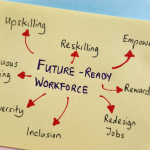Executive Summary
-
Discover how a leading retail company successfully transitioned from a traditional office setup to a fully integrated remote workforce.
-
Learn about the benefits and challenges of remote workforce integration in the retail industry.
-
Understand the step-by-step process this retail giant followed to ensure a smooth transition.
-
Gain insights from a real-world case study and expert tips on managing remote teams effectively.
Introduction
In today’s fast-paced business environment, the shift from traditional office setups to remote work models is more than a trend—it’s a necessity. For retail giants, integrating a remote workforce poses unique challenges, from managing logistics to ensuring a seamless customer experience. This transformation is crucial for staying competitive and meeting the evolving needs of both employees and customers. In this article, you’ll explore a real-world case study of a retail giant’s journey to remote workforce integration, uncovering the strategies and insights that made it a success.
Definitions / Context
Remote Workforce Integration: The process of transitioning employees from a centralized office location to working from various remote locations, often leveraging digital tools and platforms to maintain productivity and collaboration.
Retail Industry Context: The retail sector has traditionally relied on physical presence for operations, making remote workforce integration a complex endeavor that requires redefining roles, processes, and technology usage.
Benefits / Pros
-
Increased Flexibility: Employees enjoy the flexibility to work from anywhere, improving work-life balance and job satisfaction.
-
Cost Savings: Reduced overhead costs from maintaining large office spaces.
-
Broader Talent Pool: Ability to hire talent from diverse geographical locations without relocation constraints.
-
Enhanced Productivity: Many organizations report increased productivity as remote work eliminates commuting time and offers a more personalized work environment.
Risks / Cons / Challenges
-
Communication Barriers: Maintaining effective communication across remote teams can be challenging without the right tools and protocols.
-
Data Security Concerns: Protecting sensitive company and customer data becomes more complex when employees access systems from various locations.
-
Compliance and Policy Adjustments: Adapting company policies and ensuring compliance with labor laws across different regions can be daunting.
-
Employee Isolation: The lack of in-person interaction may lead to feelings of isolation among team members.
Step-by-Step Process
-
Assessment and Planning: Conduct a comprehensive analysis of operations to determine which roles can be transitioned to remote work.
-
Technology Implementation: Invest in robust communication and collaboration tools such as Slack, Zoom, and project management software.
-
Training and Development: Provide training to employees on remote work best practices and tools.
-
Policy Development: Develop clear policies regarding remote work expectations, data security, and performance metrics.
-
Pilot Program: Start with a pilot program to test the remote work model and make necessary adjustments.
-
Full-Scale Rollout: Gradually transition more employees to remote work, using feedback from the pilot program to refine processes.
Retail Giant X, a leading name in the fashion industry, embarked on a journey to integrate a remote workforce in 2021. Faced with the pandemic’s challenges, the company accelerated its digital transformation, implementing a remote work policy for its corporate and support staff. By using cloud-based solutions and investing in cybersecurity measures, Retail Giant X saw a 20% increase in productivity and reduced operational costs by 15%.
Case Study: Retail Giant X
Expert Tips / Strategic Insights
-
Prioritize Communication: Establish regular check-ins and use video conferencing to maintain face-to-face interactions.
-
Foster a Strong Company Culture: Encourage team-building activities and virtual social events to keep employees engaged.
-
Leverage Analytics: Use data analytics to monitor productivity and identify areas for improvement.
-
Continuous Feedback Loop: Create channels for regular feedback to continuously improve the remote work experience.
Tools / Resources / Calculators
-
Remote Work Policy Template: Download a free template to get started on crafting your company’s remote work policy.
-
Productivity Tracking Tools: Explore tools like Asana and Trello for managing remote work projects.
-
Cybersecurity Checklist: Access our checklist to ensure your remote work setup is secure.
Conclusion
The transition from office to remote work is a significant shift that requires strategic planning and execution. By understanding the benefits and challenges, following a structured process, and learning from industry leaders like Retail Giant X, businesses can successfully navigate this transformation. Embrace the future of work and enhance your retail operations by integrating a remote workforce.























